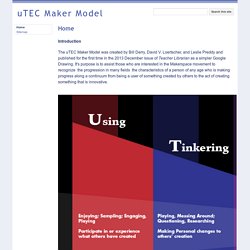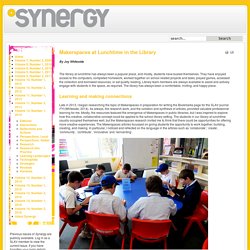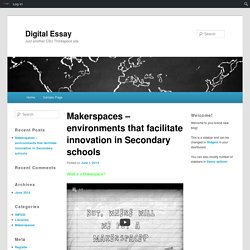

MakerspacePlaybook Dan Bowen Ictensw.pdf - Microsoft Word Online. uTEC Maker Model. He uTEC Maker Model visualizes the developmental stages of creativity from individuals and groups as they develop from passively using a system or process to the ultimate phase of creativity and invention.

As illustrated in the model below, there arefour levels of expertise. A Makerspace participant begins at the Using level. A User enjoys engaging in an activity to sample something new. Here individuals or groups use a tool, device, or program in the way—and for the purpose— the inventor intended. The User followsthrough an experience, re-creating something others have already created. Examples include learning how to, then playing the computer game, playing the musical score, or using a software program pretty much the way it was designed to be used. We recognize high levels of skill and perhaps even addictive behaviors on the part of these consumers, but they are still just at the consuming level. Apps and Websites for Makers and Creators. Makerspace in the Library! Maker Space In Education Series… 20 Reasons Your Students Should Be Making. It’s still summer time in the States and I couldn’t help but think of the idea of play, and that of course made me think of Maker Space.

I have long encourage Making in the classroom. It wasn’t until recently that I discovered that this idea is now a movement and one that I suggest all 21st century educators Make some room for. I hope you enjoy this series and I encourage you to send me information and resources, as I am also Making time to learn. First, to ensure you do not miss one of these valuable posts or other resources covering PBL, Digital Curriculum, Web 2.0, STEM, 21st century learning, and technology integration please sign up for 21centuryedtech by email or RSS.
As always, I invite you to follow me on twitter (@mjgormans). Booking Info – Time to think about your new school year needs. Makers Space Series Part 1: Maker Space In Education Series… 20 Reasons Your Students Should Be Making Part 2: Maker Space In Education Series… 10 Sites To Start Making In The Classroom. Makerspaces Australia - Home. Makerspaces at Lunchtime in the Library. The library at lunchtime has always been a popular place, and mostly, students have busied themselves.

They have enjoyed access to the computers, completed homework, worked together on school related projects and tasks, played games, accessed the collection and borrowed resources, or sat quietly reading. Library team members are always available to assist and actively engage with students in the space, as required. The library has always been a comfortable, inviting, and happy place. Late in 2013, I began researching the topic of Makerspaces in preparation for writing the Bookmarks page for the SLAV journal FYI (Whiteside, 2014). As always, the research work, and the collation and synthesis of articles, provided valuable professional learning for me. Building a castle. Makerspaces are being introduced into libraries of all types (Bagley, 2012). Citiblocs. It was at a library team meeting early in the year that I shared my learning about Makerspaces. Kelly final. Makerspaces in Australian public libraries. Makerspaces – environments that facilitate innovation in Secondary schools.
What is a Makerspace?

A Makerspace can be defined as a ” location where people gather to share resources and knowledge, work on projects, network, and build” (Educase, 2013, p. 1). People come together to create, collaborate, make things and innovate. Makerspaces facilitate cooperative learning, project-based learning, experimental hands-on activities, independent inquiry and students as producers of knowledge. They are generally in a community environment like a library, community centre, business or educational campus. Makerspaces and makers collaborate together in digital and physical spaces. The Makerspace concept has emerged from the ‘maker culture’ where there is a strong emphasis on technology. Makerspaces were firstly associated with academic institutions; mainly universities but now they are being incorporated into schools and public and school libraries. The do-it-yourself (or even better do-it –with-others) mindset is the tell-tale sign of the maker movement. 1. 2.